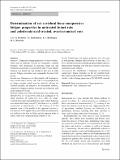| dc.contributor.author | Brouwers, J. E. M. | |
| dc.contributor.author | Ruchelsman, M. | |
| dc.contributor.author | Rietbergen, B. v. | |
| dc.contributor.author | Bouxsein, Mary Larsen | |
| dc.date.accessioned | 2011-03-04T17:24:10Z | |
| dc.date.issued | 2008 | |
| dc.identifier.citation | Brouwers, J. E. M., M. Ruchelsman, B. v. Rietbergen, and M. L. Bouxsein. 2008. Determination of rat vertebral bone compressive fatigue properties in untreated intact rats and zoledronic-acid-treated, ovariectomized rats. Osteoporosis International 20(8): 1377-1384. | en_US |
| dc.identifier.issn | 0937-941X | en_US |
| dc.identifier.uri | http://nrs.harvard.edu/urn-3:HUL.InstRepos:4737554 | |
| dc.description.abstract | Summary: Compressive fatigue properties of whole vertebrae, which may be clinically relevant for osteoporotic vertebral fractures, were determined in untreated, intact rats and zoledronic-acid-treated, ovariectomized rats. Typical fatigue behavior was found and was similar to that seen in other species. Fatigue properties were comparable between both groups. Introduction: Osteoporosis is often treated with bisphosphonates, which reduce fracture risk. Effects of bisphosphonates on fatigue strength, which may be clinically relevant for vertebral fractures, are unknown. We determined vertebral, compressive fatigue properties in normal and zoledronic acid (ZOL)-treated, OVX rats. Methods: Thirty-five-week old Wistar rats were divided into SHAM-OVX (n = 7) and OVX with ZOL treatment (n = 5; single injection, 20 μg/kg b.w. s.c.). After 16 weeks, vertebral trabecular microarchitecture and cortical thickness were determined using micro-CT. Vertebrae were cyclically compressed in load-control at 2 Hz starting at 0.75% apparent strain. A line parallel to the apparent strain curve was drawn at 0.5% higher offset, after which the intersection was defined as the time to failure and the apparent strain at failure. Data were compared using Student’s t test.Results Morphology and fatigue properties were the same in both groups. Samples failed between 10 min and 15 h. Force–displacement curves displayed typical fatigue behavior. Displacement increased over time due to mostly creep and to decreasing secant stiffness. Conclusions: We established a technique to determine compressive fatigue properties in the rat vertebral body. Our initial results indicate that ZOL-treated OVX rats have similar vertebral fatigue properties as SHAM-OVX controls. | en_US |
| dc.language.iso | en_US | en_US |
| dc.publisher | Springer-Verlag | en_US |
| dc.relation.isversionof | doi://10.1007/s00198-008-0803-z | en_US |
| dc.relation.hasversion | http://www.ncbi.nlm.nih.gov/pmc/articles/PMC2708332/pdf/ | en_US |
| dash.license | LAA | |
| dc.subject | bone microstructure | en_US |
| dc.subject | fatigue properties | en_US |
| dc.subject | osteoporosis | en_US |
| dc.subject | rats | en_US |
| dc.subject | zoledronic acid | en_US |
| dc.title | Determination of Rat Vertebral Bone Compressive Fatigue Properties in Untreated Intact Rats and Zoledronic-acid-treated, Ovariectomized Rats | en_US |
| dc.type | Journal Article | en_US |
| dc.description.version | Version of Record | en_US |
| dc.relation.journal | Osteoporosis International | en_US |
| dash.depositing.author | Bouxsein, Mary Larsen | |
| dc.date.available | 2011-03-04T17:24:10Z | |
| dash.affiliation.other | HMS^Orthopedic Surgery- Beth Israel-Deaconess | en_US |
| dc.identifier.doi | 10.1007/s00198-008-0803-z | * |
| dash.contributor.affiliated | Bouxsein, Mary | |


